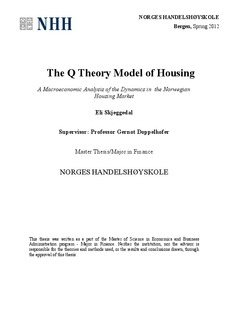The Q theory model of housing : a macroeconomic analysis of the dynamics in the Norwegian housing market
Abstract
This thesis develops a q theory model of housing, where the value of Norwegian housing, q,
is defined as the ratio of housing prices to the construction costs of new housing and housing
is defined as the aggregate housing stock in Norway’s national accounts. This thesis analyzes
the development in q during the period 1992-2011 and show that q is positively and
significantly related to housing investment when assuming that shocks in the economy are
both absent and present. In the assumption that shocks are present in the economy,
developments in income, debt, population, initiation of new housing construction, interest
rates and taxes where analyzed. Empirical estimates show that the developments in
population and interest rates in particular may explain the variance in q. The positive
relationship between the value of housing and the aggregate housing stock suggests that
there may be a presence of bubbles in the Norwegian housing market and that the dynamics
in the housing market may be influenced by non-fundamental variables such as animal
spirits and irrational exuberance. This finding must however be interpreted with caution
since it is difficult to measure bubbles before they have burst. In addition, the empirical
estimates have not accounted for all the variables that may impact the dynamics of the
housing market and it is discussed that land prices in particular may have contributed to the
rising housing prices. Thus it can neither be proved nor disproved that a bubble may exist in
the Norwegian housing market. Nevertheless, this does not alter the main result in this thesis,
that the value of housing is significantly related to housing investment according to the q
theory model of housing.
